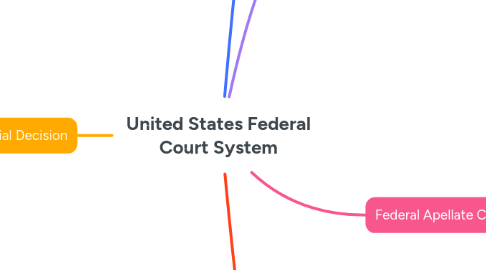
1. Judicial Decision
1.1. Court Issues its rulings and opionions
1.1.1. The majority opinion(the opinion where more the half of the judges agree) is binding
1.1.1.1. Concurring Opinion (opinion that agrees with the majority decision, offering different or additional reasoning) may be written by the judges
1.1.2. If no majority can be reached, a plurality opinion (an appellate opinion reached beacuse the judges can not agree on a majority) is reached.
1.1.2.1. Dissenting Opinion (opinion that disagrees with the majority opinion and does not serve as precedent) are written by justices who disagree with majority and are trying to influence later courts
2. State Courts
2.1. Handle the vast majority of court cases in the US
2.2. State Judicial System Handles:
2.2.1. Criminal Cases
2.2.2. Civil Cases
2.3. States System of Trial Courts:
2.3.1. does most of the work of the states judiciary
2.3.2. handles cases arising under that states laws
2.3.3. possesses original jurisdiction
2.4. Specialized Courts:
2.4.1. handles issues of traffic violations, family disputes, and small claims
2.5. State Supreme Court:
2.5.1. Acts as the highest court in that states system and as the final level of appeal
3. Federal District Courts
3.1. Lowest level of the federal judicary
3.2. Most cases end here by settlement or by losing party's decision not to appeal
3.3. Acts as the trial courts and possess original jurisdiction
3.4. 94 district courts in the US and each state has at least 1
4. Federal Apellate Court
4.1. Middle level of federal judiciary
4.2. Amicus Curiae is a person who is not a party to a case and they will help the appellate courts by giving additional information and arguments that the judges can consider before making decisions
4.3. Focus on how the decision of the court was rendered and of the decision was appropriate
4.4. Cases can be:
4.4.1. Affirmed: conforming the district court decision
4.4.2. Reversed: overturning the district court decision
4.4.3. Remanded: sent back to the lower court for reconsideration
5. Federal Supreme Court
5.1. Constitution establishes as highest court in the nation
5.2. Losing side of Apellate Court appeals here
5.3. Supreme court decisions set a precendent ( a judical decision that acts as a bias for decidning similar cases in the future)
5.3.1. Under the principle of stare decisis, the Supreme Court may avoid creating a new precedent by allowing a previous decision to stand
5.4. Upon appeal Supreme Court may:
5.4.1. Refuse to hear (most common)
5.4.2. Decide to hear case relying on Rule Of Four (Four or more justices must agree to hear a specific case)
5.4.2.1. if case presents a federal question
5.4.2.2. if case would resolve conflicting interpretations
5.4.2.3. parties to the case file breifs
5.4.2.4. prefefrnces of indiviual justices
5.4.3. If case is accepted..
5.4.3.1. Court issues writ of certiorari(higher court reviews a decision of a lower court)
5.4.3.1.1. Oral arguements presented by each side
